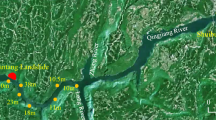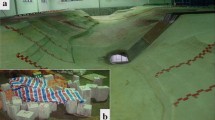Abstract
In this work, a two-layer depth-integrated smoothed particle hydrodynamics (SPH) model is applied to investigate the effects of landslide propagation on the impulsive waves generated when entering a water body. In order to deal with the open boundary in practical engineering problems, an absorbing boundary method, based on Riemann invariants which can be applied to arbitrary geometries, is implemented. In order to examine the accuracy of the proposed formulation, the model is tested against both available laboratory tests and numerical examples from the literature. Then, it is adopted to model the characteristics of the impulse waves generated by the Halaowo landslide in the Jinsha River, China. The results provide a technical basis for the emergency plan to the Halaowo landslide and benefit the disaster prevention policy, which helps mitigating future hazards in similar reservoir areas.





















Similar content being viewed by others
References
Ataie-Ashtiani B, Jilani AN (2007) A higher-order Boussinesq-type model with moving bottom boundary: applications to submarine landslide tsunami waves. Int J Numer Methods Fluids 53:1019–1048
Ataie-Ashtiani B, Najafi-Jilani A (2006) Prediction of submerged landslide generated waves in dam reservoirs: an applied approach. 17
Ataie-Ashtiani B, Nik-Khah A (2008) Impulsive waves caused by subaerial landslides. Environ Fluid Mech 8:263–280
Ataie-Ashtiani B, Shobeyri G (2008) Numerical simulation of landslide impulsive waves by incompressible smoothed particle hydrodynamics. Int J Numer Methods Fluids 56:209–232
Bouchut F, Bresch D, Mangeney A (2008) A new savage-hutter type model for submarine avalanches and generated tsunami. J Comput Phys 227:7720–7754
Carvalho RFD, Carmo JSAD (2007) Landslides into reservoirs and their impacts on banks. Environ Fluid Mech 7:481–493
Dai FC, Deng JH, Tham LG, Law KT, Lee CF (2004) A large landslide in Zigui County, Three Gorges area. Canadian Geotechnical Journal 41(6): 1233-1240
Fritz HM, Hager WH, Minor H-E (2001) Lituya bay case rockslide impact and wave run-up. Sci Tsunami Haz 19:3–19
Fritz HM, Mohammed F, Yoo J (2009) Lituya bay landslide impact generated mega-tsunami 50th anniversary. Birkhäuser, Basel
Gabl R, Seibl J, Gems B, Aufleger M (2015) 3-d numerical approach to simulate the overtopping volume caused by an impulse wave comparable to avalanche impact in a reservoir. Nat Hazards Earth Syst Sci 15:2617–2630
Gomez-Gesteira M, Crespo AJC, Rogers BD, Dalrymple RA, Dominguez JM, Barreiro A (2012) Sphysics – development of a free-surface fluid solver – part 2: efficiency and test cases. Comput Geosci 48:300–307
Gotoh H, Sakai T (2006) Key issues in the particle method for computation of wave breaking. Coast Eng 53:171–179
Gray JMNT, Wieland M, Hutter K (1999) Gravity-driven free surface flow of granular avalanches over complex basal topography. Proc Math Phys Eng Sci 455:1841–1874
Heller V, Bruggemann M, Spinneken J, Rogers BD (2016) Composite modelling of subaerial landslide–tsunamis in different water body geometries and novel insight into slide and wave kinematics. Coast Eng 109:20–41
Huang Z, Law KT, Liu H, Tong J (2009) The chaotic characteristics of landslide evolution: a case study of Xintan landslide. Environ Geol 56:1585–1591
Huang B, Yin Y, Chen X, Liu G, Wang S, Jiang Z (2014) Experimental modeling of tsunamis generated by subaerial landslides: two case studies of the three gorges reservoir, China. Environ Earth Sci 71:3813–3825
Huber A, Hager WH (1997) Forecasting impulse waves in reservoirs
Hutter K, Koch T (1991) Motion of a granular avalanche in an exponentially curved chute: experiments and theoretical predictions. Philos Trans R Soc A Math Phys Eng Sci 334:93–138
Hutter K, Siegel M, Savage SB, Nohguchi Y (1993) Two-dimensional spreading of a granular avalanche down an inclined plane part i. Theory. Acta Mech 100:37–68
Kamphuis JW, Bowering RJ (1970) Impulse waves generated by landslides. Coast Eng 1970:575–588
Laigle D, Coussot P (1997) Numerical modeling of mudflows. J Hydraul Eng 123:617–623
Lastiwka M, Quinlan N, Basa M (2005) Adaptive particle distribution for smoothed particle hydrodynamics. Int J Numer Methods Fluids 47:1403–1409
Liu Y, Wang X, Wu Z, He Z, Yang Q (2018) Simulation of landslide-induced surges and analysis of impact on dam based on stability evaluation of reservoir bank slope. Landslides 1–15
Lucy LB (1977) A numerical approach to the testing of the fission hypothesis. Astron J 82:1013–1024
Ma G, Kirby JT, Hsu TJ, Shi F (2015) A two-layer granular landslide model for tsunami wave generation: theory and computation. Ocean Model 93:40–55
Macías J, Vázquez JT, Fernández-Salas LM, González-Vida JM, Bárcenas P, Castro MJ, Díaz-Del-Río V, Alonso B (2015) The al-borani submarine landslide and associated tsunami. A modelling approach ☆. Mar Geol 361:79–95
Majd MS, Sanders BF (2014) The lhllc scheme for two-layer and two-phase transcritical flows over a mobile bed with avalanching, wetting and drying. Adv Water Resour 67:16–31
Manzanal D, Drempetic V, Haddad B, Pastor M, Stickle MM, Mira P (2016) Application of a new rheological model to rock avalanches: an sph approach. Rock Mech Rock Eng 49:2353–2372
Mao J, Zhao LH, Liu XN, Cheng J, Avital E (2017) A three-phases model for the simulation of landslide-generated waves using the improved conservative level set method. Comput Fluids 159:243–253. https://doi.org/10.1016/j.compfluid.2017.10.007
McDougall S, Hungr O (2004) A model for the analysis of rapid landslide motion across three-dimensional terrain. Can Geotech J 41:1084–1097
Miyagi T, Yamashina S, Esaka F, Abe S (2011) Massive landslide triggered by 2008 Iwate–Miyagi inland earthquake in the aratozawa dam area, tohoku, Japan. Landslides 8:99–108
Monaghan JJ (1985) Particle methods for hydrodynamics. Computer Phys Rep 3:71–124
Monaghan JJ, Gingold RA (1983) Shock simulation by the particle method sph. J Comput Phys 52:374–389
Monaghan JJ, Kos A (1999) Solitary waves on a cretan beach. J WaterwPort Coast Ocean Eng 125:145–155
Monaghan JJ, Kos A (2000) Scott Russell’s wave generator. Phys Fluids 12:622–630
Noda E (1970) Water waves generated by landslides. J Waterw Harb Coast Eng Div 96:835–855
Oppikofer T, Hermanns RL, Roberts NJ, Böhme M (2018) Splash: semi-empirical prediction of landslide-generated displacement wave run-up heights
Panizzo A, Dalrymple RA (2005) Sph modelling of underwater landslide generated waves. Coastal engineering 2004 - international conference, pp 1147–1159
Pastor M, Quecedo M, Merodo JAF, Herrores MI, González E, Mira P (2002) Modelling tailings dams and mine waste dumps failures ¶. Geotechnique 52:págs. 579–págs. 592
Pastor M, Quecedo M, González E, Herreros M, Merodo JF, Mira P (2004) Simple approximation to bottom friction for Bingham fluid depth integrated models. J Hydraul Eng 130:149–155
Pastor M, Haddad B, Sorbino G, Cuomo S, Drempetic V (2009a) A depth-integrated, coupled sph model for flow-like landslides and related phenomena. Int J Numer Anal Methods Geomech 33:143–172. https://doi.org/10.1002/nag.705
Pastor M, Herreros I, Merodo JF, Mira P, Haddad B, Quecedo M, González E, Alvarez-Cedrón C, Drempetic V (2009b) Modelling of fast catastrophic landslides and impulse waves induced by them in fjords, lakes and reservoirs. Eng Geol 109:124–134
Pastor M, Yague A, Stickle MM, Manzanal D, Mira P (2017) A two-phase sph model for debris flow propagation. Int J Numer Anal Methods Geomech
Peraire J, Zienkiewicz OC, Morgan K (1986) Shallow water problems: a general explicit formulation. Int J Numer Methods Eng 22:547–574. https://doi.org/10.1002/nme.1620220305
Petley D (2010) Geomorphological hazards and disaster prevention: landslide hazards
Pudasaini SP, Hutter K (2007) Avalanche dynamics: dynamics of rapid flows of dense granular avalanches
Quecedo M, Pastor M, Herreros M (2004a) Numerical modelling of impulse wave generated by fast landslides. Int J Numer Methods Eng 59:1633–1656
Quecedo M, Pastor M, Herreros MI, Merodo JAF (2004b) Numerical modelling of the propagation of fast landslides using the finite element method. Int J Numer Methods Eng 59:755–794
Renzi E, Sammarco P (2016) The hydrodynamics of landslide tsunamis: current analytical models and future research directions. Landslides 13:1369–1377. https://doi.org/10.1007/s10346-016-0680-z
Rodriguez-Paz M, Bonet J (2005) A corrected smooth particle hydrodynamics formulation of the shallow-water equations. Comput Struct 83:1396–1410
Sammarco P, Renzi E (2008) Landslide tsunamis propagating along a plane beach. J Fluid Mech 598:107–119
Savage SB, Hutter K (1991) The dynamics of avalanches of granular materials from initiation to runout. Part i: analysis. Acta Mech 86:201–223
Tatiana C, Panizzo A, Monaghan JJ (2010) Sph modelling of water waves generated by submarine landslides. J Hydraul Res 48:80–84
Vacondio R, Rogers B, Stansby P, Mignosa P (2012) Sph modeling of shallow flow with open boundaries for practical flood simulation. J Hydraul Eng 138:530–541
Vacondio R, Mignosa P, Pagani S (2013) 3d sph numerical simulation of the wave generated by the vajont rockslide. Adv Water Resour 59:146–156
Viroulet S, Cébron D, Kimmoun O, Kharif C (2013) Shallow water waves generated by subaerial solid landslides. Geophys J Int 193:747–762
Walder JS, Watts P, Sorensen OE, Janssen K (2003) Tsunamis generated by subaerial mass flows. J Geophys Res Solid Earth 108
Wang W, Chen G, Yin K, Wang Y, Zhou S, Liu Y (2016) Modeling of landslide generated impulsive waves considering complex topography in reservoir area. Environ Earth Sci 75:372
Xie J, Tai YC, Jin YC (2014) Study of the free surface flow of water–kaolinite mixture by moving particle semi-implicit (mps) method. Int J Numer Anal Methods Geomech 38:811–827
Yavari-Ramshe S, Ataie-Ashtiani B (2015) A rigorous finite volume model to simulate subaerial and submarine landslide-generated waves. Landslides:1–19
Yavari-Ramshe S, Ataie-Ashtiani B (2016) Numerical modeling of subaerial and submarine landslide-generated tsunami waves-recent advances and future challenges. Landslides 13:1325–1368. https://doi.org/10.1007/s10346-016-0734-2
Zhu Y, Fox PJ (2001) Smoothed particle hydrodynamics model for diffusion through porous media. Transp Porous Media 43:441–471
Funding
This work is supported by the National Key Research and Development Plan (Grant No.2018YFC047102), the Priority Academic Program Development of Jiangsu Higher Education Institutions (Grant YS11001), and the Postgraduate Research & Practice Innovation Program of Jiangsu Province (KYZZ16_0282). The second author wishes to express his gratitude to the Spanish MINECO for the financial help granted (Project ALAS, BIA2016-76253-P).
Author information
Authors and Affiliations
Corresponding author
Rights and permissions
About this article
Cite this article
Lin, C., Pastor, M., Li, T. et al. A SPH two-layer depth-integrated model for landslide-generated waves in reservoirs: application to Halaowo in Jinsha River (China). Landslides 16, 2167–2185 (2019). https://doi.org/10.1007/s10346-019-01204-9
Received:
Accepted:
Published:
Issue Date:
DOI: https://doi.org/10.1007/s10346-019-01204-9




